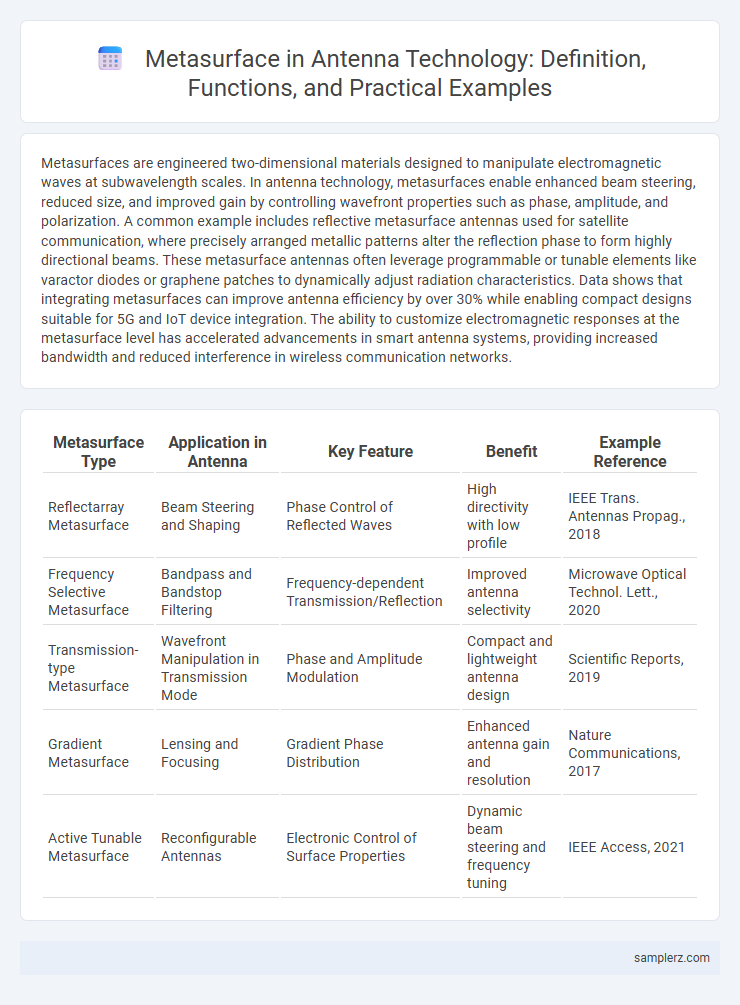Metasurfaces are engineered two-dimensional materials designed to manipulate electromagnetic waves at subwavelength scales. In antenna technology, metasurfaces enable enhanced beam steering, reduced size, and improved gain by controlling wavefront properties such as phase, amplitude, and polarization. A common example includes reflective metasurface antennas used for satellite communication, where precisely arranged metallic patterns alter the reflection phase to form highly directional beams. These metasurface antennas often leverage programmable or tunable elements like varactor diodes or graphene patches to dynamically adjust radiation characteristics. Data shows that integrating metasurfaces can improve antenna efficiency by over 30% while enabling compact designs suitable for 5G and IoT device integration. The ability to customize electromagnetic responses at the metasurface level has accelerated advancements in smart antenna systems, providing increased bandwidth and reduced interference in wireless communication networks.
Table of Comparison
| Metasurface Type | Application in Antenna | Key Feature | Benefit | Example Reference |
|---|---|---|---|---|
| Reflectarray Metasurface | Beam Steering and Shaping | Phase Control of Reflected Waves | High directivity with low profile | IEEE Trans. Antennas Propag., 2018 |
| Frequency Selective Metasurface | Bandpass and Bandstop Filtering | Frequency-dependent Transmission/Reflection | Improved antenna selectivity | Microwave Optical Technol. Lett., 2020 |
| Transmission-type Metasurface | Wavefront Manipulation in Transmission Mode | Phase and Amplitude Modulation | Compact and lightweight antenna design | Scientific Reports, 2019 |
| Gradient Metasurface | Lensing and Focusing | Gradient Phase Distribution | Enhanced antenna gain and resolution | Nature Communications, 2017 |
| Active Tunable Metasurface | Reconfigurable Antennas | Electronic Control of Surface Properties | Dynamic beam steering and frequency tuning | IEEE Access, 2021 |
Introduction to Metasurfaces in Antenna Technology
Metasurfaces in antenna technology enable precise control of electromagnetic waves by manipulating the phase, amplitude, and polarization at a subwavelength scale. These engineered surfaces enhance antenna performance by improving beam steering, gain, and bandwidth without increasing physical size. Advanced designs such as gradient metasurfaces and tunable metasurfaces demonstrate significant potential for compact, high-efficiency antennas in 5G and IoT applications.
Fundamentals of Metasurface-Enabled Antennas
Metasurface-enabled antennas leverage engineered two-dimensional structures to manipulate electromagnetic waves with high precision, enhancing antenna performance through tailored reflection, refraction, and polarization control. Fundamental principles include subwavelength patterning and phase discontinuities, which enable wavefront shaping and beam steering without bulky components. These antenna designs achieve improved gain, bandwidth, and efficiency by exploiting the unique electromagnetic responses of metasurfaces at microwave and millimeter-wave frequencies.
Application of Frequency Selective Metasurfaces in Antennas
Frequency selective metasurfaces (FSS) enhance antenna performance by enabling precise control over electromagnetic wave propagation, filtering specific frequency bands while allowing others to pass. These metasurfaces improve antenna gain, bandwidth, and radiation patterns by integrating frequency selective surfaces as reflectors or substrates in antenna design. Applications in radar systems, satellite communications, and 5G networks benefit from FSS-based antennas due to their compact size, lightweight structure, and improved spectral selectivity.
Reconfigurable Metasurface Antennas: Case Studies
Reconfigurable metasurface antennas demonstrate advanced beam steering and polarization control capabilities through electrically tunable elements integrated into the metasurface design. Case studies include the use of varactor diodes and microelectromechanical systems (MEMS) to dynamically adjust radiation patterns in applications such as 5G communications and radar systems. These antennas achieve enhanced signal directivity and bandwidth adaptability while maintaining low profile and lightweight structures.
Metasurface-Based Beam Steering Antenna Systems
Metasurface-based beam steering antenna systems utilize engineered ultrathin layers with subwavelength structures to dynamically control electromagnetic wavefronts, enabling precise directional beamforming without mechanical movement. These antennas achieve high angular resolution and wide steering range, which significantly enhance signal strength and reduce interference in wireless communication networks. Advanced metasurface designs incorporate tunable materials such as graphene or liquid crystals to provide real-time adaptability for 5G and beyond communication technologies.
Metasurface-Driven Miniaturization of Antennas
Metasurface-driven miniaturization of antennas enables significant size reduction by manipulating electromagnetic waves through engineered subwavelength structures, enhancing antenna performance without increasing physical dimensions. These metasurfaces facilitate improved impedance matching, bandwidth, and radiation efficiency, making compact antennas viable for modern wireless communication systems. Practical applications include portable devices and IoT sensors where space constraints demand highly efficient, miniaturized antenna designs.
Intelligent Reflecting Metasurfaces for Next-Gen Wireless Networks
Intelligent Reflecting Metasurfaces (IRMs) are revolutionizing next-generation wireless networks by dynamically controlling electromagnetic waves to optimize signal strength and coverage. IRMs enable real-time beamforming and interference management, significantly enhancing data rates and energy efficiency in 5G and beyond systems. Their integration into antenna design supports adaptive, programmable wireless environments crucial for ultra-reliable low-latency communications and massive device connectivity.
Broadband Performance Using Metasurfaces in Antennas
Broadband performance in antennas is significantly enhanced by integrating metasurfaces, which manipulate electromagnetic waves to achieve wide frequency coverage and improved radiation efficiency. These engineered metasurfaces enable compact antenna designs with reduced size and weight while maintaining high gain across broad spectral ranges. Advanced metasurface-based antennas demonstrate superior impedance matching and beam steering capabilities, optimizing signal quality for various wireless communication applications.
Metasurface-Assisted MIMO Antenna Designs
Metasurface-assisted MIMO antenna designs enhance wireless communication by increasing channel capacity and reducing interference through engineered surfaces that manipulate electromagnetic waves. These metasurfaces enable compact, high-gain antennas with improved isolation and beam steering capabilities, crucial for 5G and beyond technologies. Recent examples demonstrate how tailored metasurface elements significantly improve MIMO system performance by controlling polarization and spatial diversity efficiently.
Future Trends and Challenges in Metasurface Antenna Integration
Metasurface antennas are expected to revolutionize wireless communication by enabling ultra-compact, high-gain, and beam-steerable designs through programmable electromagnetic wave manipulation. Future trends include integrating AI-driven adaptive control systems for dynamic beam shaping and leveraging 5G and beyond frequencies to enhance spectrum efficiency and connectivity. Challenges remain in scaling fabrication techniques for mass production, managing thermal effects, and ensuring seamless integration with existing RF components and protocols.

example of metasurface in antenna Infographic
 samplerz.com
samplerz.com